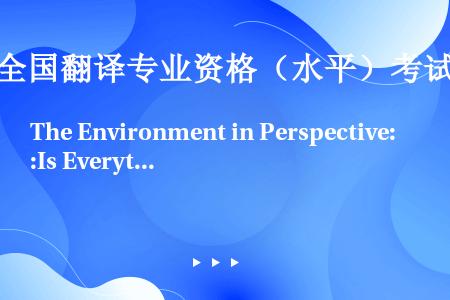 问答题
问答题
The Environment in Perspective:Is Everything Getting Steadily Worse? Much of the discussion of environmental problems in the popular press leaves the reader with the impression that matters have been growing steadily worse, and that pollution is largely a product of the profit system and modern industrialization. There are environmental problems today that are both enormous and pressing, but in fact pollution is nothing new. Medieval cities were pestholes—the streets and rivers were littered with garbage and the air stank of rotting wastes. At the beginning of the eighteenth century, a German traveler reported that to get a view of London from the tower of St. Paul’s, one had to get there very early in the morning “before the air was full of coal smoke.” Since 1960 there has been progress in solving some pollution problems, much of it the result of concerted efforts to protect the environment. The quality of the air in most Canadian cities has improved. In Toronto, for example, the concentration of suspended particulates, or soot, in the air has fallen dramatically since 1962. To put this figure in perspective, it should be noted that the current health advisory level for the index is 32. At a level of 58, people with chronic respiratory diseases may be affected. At 100, even healthy people may be affected by prolonged conditions, and those with cardiac and respiratory diseases could suffer severe effects Recently in Toronto, the index has exceeded 32 on fewer than half a dozen days annually. Similar improvements have occurred elsewhere in Canada and in other industrialized countries. Even the famous, or rather infamous, “fogs” of London are almost a thing of the past. There have been two high readings of particular note in the British capital in 1959 (when the index rose to 275 and there was a 10 percent increase over the normal number of deaths) and in 1962 (when the index rose to 575 and there was a 20 percent increase in mortality). But more recently, London’s, cleaner air has resulted in an astounding 50 percent increase in the number of hours of winter sunshine. In short, pollution problems are not a uniquely modem phenomenon, nor is every part of the environment deteriorating relentlessly. Environmental problems do not occur exclusively in capitalist economies. For example, in the People’s Republic of China, coal soot from factory smokestacks in Beijing envelops the city in a thick black haze. Similarly, smoke from brown-coal furnaces pollutes the air almost everywhere in Eastern Europe. It has been estimated that a third of Poland’s citizens live in areas of “ecological disaster”. The citizens of Leipzig, a major industrial city in what was formerly East Germany, have a life expectancy a full six years shorter than the national average. However, we do not mean to suggest that all is well with the environment in market-oriented economies or that there is nothing more to do. While there have been some improvements, serious problems remain. Our world is now subject to a number of new pollutants, most of which are far more dangerous than those we have reduced, even though they may be less visible and less malodorous While environmental problems are neither new nor confined only to capitalist, industrialized economies, these facts are not legitimate grounds for complacency. The potential damage that we are inflicting on ourselves and on our surroundings is very real and very substantial.
发布日期:2021-08-18


题王网让考试变得更简单
扫码关注题王,更多免费功能准备上线!

此试题出现在
其他考试
如客户被列入()名单,信贷系统在客户名称后给予红字标识,作为授信管理的风险提示,但不限制该客户在系统中办理业务。
嘉靖年款
胃充盈造影显示十二指肠淤滞症的声像图表现为( )。
基站退服主要由于()、()、()和()等原因引起,监控人员需要关联无线、传输、动环等专业的相关信息,准确定位告警产生的具体原因,及时有效处理故障点。
下列弹簧中重量大,体积大,对高频振动不敏感的是()
10个月女婴,独自坐不稳,能抓物,不能换手,能描话,能认生,发育筛查时首选()
下列关于科举考试的说法,正确的是( )。
上、下部固定绳弹簧补偿器处于固定绳受力()的一侧,张力符合设计规定。
小儿胸部体查的内容。
属于改扩建项目经济评价中使用的一种数据之一的是()。
2022年度贵州翻译专业资格(水平)考试考点考场的通知
2022年度上半年翻译资格考试证书预发放公告
2020年全国翻译专业资格考试朝鲜语/韩语口译一级(交替传译)考试大纲
外语翻译资格考试CATTI国际版(中英)考试大纲
2020年全国外语翻译资格水平考试俄语海外考试准考证发放公告
2020年全国外语翻译资格水平考试CATTI国际版开考公告
2020年全国翻译专业资格考试朝鲜语/韩语笔译三级考试大纲
2022年下半年翻译专业资格(水平)考试现场人工核查安排
2022年度下半年翻译专业资格(水平)考试
2022年度上半年翻译专业资格(水平)考试补考时间及网上确认的通知
The Environment in Perspective:Is Everything Getting Steadily Worse? Much of th...
The number of such vehicles()steadily increasing.
The number of international students at our university ______ steadily, but a nu...
The emphasis of the product perspective on grammar is on the component parts of ...
It is important to note that from the core company’s perspective, the supply cha...
From a design perspective which two of the following OHPF Statements are most re...
Dans «La perspective de profiter de week-ends complets, plus en phase avec nos m...
From the perspective of routerPG-1,what kind of router is the router with IP add...
______
______

